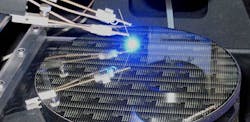Low-cost LEDs goal of $1.5M GaN-on-Si growth facility at University of Cambridge
Cambridge, England--A new facility for growing gallium nitride on silicon (GaN-on-Si) light-emitting diodes (LEDs) has opened in Cambridge, enabling researchers to expand and accelerate their pioneering work in the field. While LEDs are already used in traffic lights, bicycle lights, televisions, computer screens, car headlamps and other devices, they are still too expensive to be used widely in homes and offices for lighting, primarily because they are grown on expensive substrates that push up the price of LED light bulbs. The new GaN-on-Si growth reactor at the University of Cambridge will allow researchers to further improve a method of growing low-cost LEDs (http://www.laserfocusworld.com/articles/2011/12/first-leds-fabricated-on-amorphous-glass-substrates.html) on silicon substrates, reducing their cost by more than 50% and opening them up for more general use.
LED technology (http://www.laserfocusworld.com/articles/2013/01/coating-that-mimics-firefly-scales-makes-leds-more-efficient.html) is already so energy efficient that it is estimated that the overall demand for electricity would fall by at least 10% if every home and business in the UK switched to LED lighting, saving the UK more than $3B dollars per year in electricity costs. In addition, researchers are developing color-tunable LED lighting, which would have the quality of natural sunlight, bringing considerable health benefits to users.
The reactor, which is funded by the Engineering and Physical Sciences Research Council (EPSRC), was opened on March 28 by David Willetts MP, the Minister for Universities and Science. It marks the latest chapter in a decade-long research project to make LEDs the go-to technology for lighting, led by Professor Sir Colin Humphreys in the University's Department of Materials Science and Metallurgy.
In 2003, Humphreys and his team began experimenting with the possibility of growing Gallium Nitride (GaN) on silicon instead of costly sapphire and silicon carbide. After years of painstaking research, they finally developed a successful process, and in 2012 this was picked up by the British manufacturer, Plessey (http://www.laserfocusworld.com/articles/oiq/2012/02/plessey-acquires-camgan.html), which has already started to manufacture LEDs at its factory in Plymouth, based on the Cambridge technology. Plessey also hired three of Humphreys’ post-doctoral scientists to help transfer the process. It is the first time that LEDs have been manufactured in the UK.
"At the moment, a 48-watt LED lightbulb, made from GaN on sapphire LEDs, costs about £15," Humphreys said. "That's a cost that you make back several times, because the bulbs last for so long, but it is too much to convince most customers to buy them. The research we have already performed on GaN on silicon LEDs, plus that which we will carry out in this new reactor, will mean that soon people will be able to buy an LED bulb for just £3 instead."
Minister for Universities and Science David Willetts said, "LEDs are highly energy efficient but expensive to produce, meaning their domestic use is limited. This excellent new facility will enable researchers to look at more cost-efficient ways to produce LEDs, saving money and benefitting the environment. It will also help keep the UK research base at the very forefront of advanced materials, which is one of the eight great technologies."
Humphreys is also investigating the possibility of "smart lighting"—a system in which LED lights coupled to a sensor would be able to switch them on and off, or alter their brightness, relative to a user’s presence or levels of natural daylight in a room. As their use increases, the beams from LEDs could be used to transmit information, for example from traffic lights to cars. "It's conceivable that the two could be developed to talk to one another," Humphreys said. "Traffic reports, such as information about a road accident, could be sent to traffic light systems. They could then relay the details to drivers by transmitting it through the headlamps."
Further energy-saving with LEDs may also be possible. Humphreys and his team are currently investigating the so-called "green gap" problem which could improve the way in which they make white light; a better way of making white light could be by mixing blue, red and green LEDs together instead.
As well as being used to make affordable, efficient LED lighting, researchers believe that GaN could also improve the efficiency of "power electronics"--shorthand for a wide range of devices, circuits, and systems that manage electrical energy. As with lighting, the use of GaN would improve their energy efficiency. He and colleagues from several other British Universities have just been awarded a grant by the Engineering and Physical Sciences Research Council (EPSRC) to develop and prototype highly efficient, GaN power electronic devices that could underpin new applications in sectors such as the automotive, aerospace, consumer electronics, lighting, healthcare and energy industries.
SOURCE: University of Cambridge; http://www.cam.ac.uk/research/news/low-cost-leds-for-saving-energy-and-improving-health

Gail Overton | Senior Editor (2004-2020)
Gail has more than 30 years of engineering, marketing, product management, and editorial experience in the photonics and optical communications industry. Before joining the staff at Laser Focus World in 2004, she held many product management and product marketing roles in the fiber-optics industry, most notably at Hughes (El Segundo, CA), GTE Labs (Waltham, MA), Corning (Corning, NY), Photon Kinetics (Beaverton, OR), and Newport Corporation (Irvine, CA). During her marketing career, Gail published articles in WDM Solutions and Sensors magazine and traveled internationally to conduct product and sales training. Gail received her BS degree in physics, with an emphasis in optics, from San Diego State University in San Diego, CA in May 1986.
